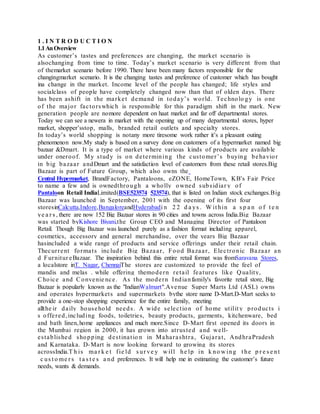This document discusses research on customer buying behavior and satisfaction levels at Big Bazaar and DMart hypermarkets in India. It provides background on the changing retail landscape in India with the rise of department stores, hypermarkets, malls, and branded outlets. The study aims to understand current customer tastes, needs, and preferences when shopping at these modern retail formats. It outlines the research methodology, including primary data collection through customer and retailer surveys in four cities in Western Maharashtra, as well as secondary data collection from sources like books, journals, newspapers and the internet. The sample size of the study is 500 customers equally distributed across the four cities.





















![- A case study on Customer
Relationship Management at Big Bazaar in Surat city -
Paripex - Indian Journal of Research, Volume 1, Issue 10.
) - Retail Marketing in India - Key
Issues and challenges - Marketing Mastermind, Delhi.
(2012) -Emergence of Retailing Sector in India: Challenges
and Opportunities - International Journal of Management &
Business Studies, Vol. 2, Issue 4.
- The effect of FDI on India and Chinese
Economy; A comparative analysis - Social Science Research
Network.
- A
Study On Organized Retailing And Its Challenges And Retail
Customer Services - Innovative Journal of Business and
Management.
- An Analysis of Consumer
Perception Towards Retail Brands in Big Bazaar, Chennai -
Indian Journal Of Applied Research, Volume 4, Issue 2, Feb
2014.
A Study of Innovative Marketing Practices In Retail Marketing
Sector with Special Reference to Big Bazaars in Maharashtra State. 2015
Bibliography Page 328
- A Study
On The Consumer Perception Towards Private Label Brands
With Special Reference To Big Bazaar, Coimbatore, Tamil
Nadu - Journal of Arts, Science & Commerce, Vol.– III, Issue
–3 (3).
- Foreign Direct Investment in Indian
Retail Sector - A SWOT Analysis - AISECT University
Journal Vol. II/Issue IV Sep.
-
Customer Satisfaction and Brand Loyalty towards Corporate
Retail Store - [A Case Study of Big Bazaar Retail Store in
Bangalore City] - IOSR Journal of Economics and Finance.
- A Study on
Customer Relationship Management Practices in Selected
Organised Retail Stores in Udaipur City - Pacific Business
Review - A Quarterly Refereed Journal.
n and N. Sumathi (2011) -A Study On Consumer
Perception Towards Retail Chains At Trichy – Smart Journal
of Business Management Studies, Vol - 7 Number – 2, July -
December 2011.
Kumar and B.Santosh (2013) -An empirical study on
customer perception towards service quality in organized](https://image.slidesharecdn.com/project3-200306024817/85/Project-3-22-320.jpg)



![India’s retail sector: Factors for success -
www.pwc.com/india
- Big Bazaar -
http://business.mapsofindia.com/india-retail-industry.
- Big Bazaar India -
http://goindia.about.com
- Future Bazaar India Ltd. -
http://bigbazaar.futurebazaar.com
- Big Bazaar Maha Bachat -
http://www.indiasummary.com
(2013) - Foreign Direct Investment (FDI) in
India’s Retail Sector - http://www.spaceandculture.in
A Study of Innovative Marketing Practices In Retail Marketing
Sector with Special Reference to Big Bazaars in Maharashtra State. 2015
Bibliography Page 334
http://www.ukessays.com.
-
http://retailrise.com
Outlook -
http://www.dnb.co.in/IndianRetailIndustry/overview.
-
http://www.bestmediainfo.com
(2011) - A Study on Customer Satisfaction –with Reference to
Big Bazaar Hyderabad - http://www.studymode.com.
- Promotional Strategy of Big Bazaar &
Maintaining the image in Retailing. [Online] -
http://www.skylinecollege.com
- Indian Retail
Industry – Its Growth, Challenges and Opportunities -
http://www.fibre2fashion.com.
- Big Bazaar – India’s Real Retail Story
- http://www.moneycontrol.com
- Meaning, Need and its Features
- http://managementstudyguide.com
-FDI in Retail in
India: An Empirical Analysis - http://mpra.ub.unimuenchen.
de.
-
http://www.rasci.in
A Study of Innovative Marketing Practices In Retail Marketing
Sector with Special Reference to Big Bazaars in Maharashtra State. 2015
Bibliography Page 335
- BIG reasons of Big Bazaar’s success -](https://image.slidesharecdn.com/project3-200306024817/85/Project-3-26-320.jpg)
